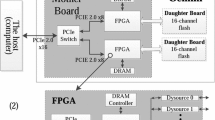Abstract
Many scientific applications are limited by I/O performance offered by parallel file systems on conventional storage systems. Flash-based burst buffers provide significant better performance than HDD backed storage, but at the expense of capacity. Burst buffers are considered as the next step towards achieving wire-speed of interconnect and providing more predictable low latency I/O, which are the holy grail of storage.
A critical evaluation of storage technology is mandatory as there is no long-term experience with performance behavior for particular applications scenarios. The evaluation enables data centers choosing the right products and system architects the integration in HPC architectures.
This paper investigates the native performance of DDN-IME, a flash-based burst buffer solution. Then, it takes a closer look at the IME-FUSE file systems, which uses IMEs as burst buffer and a Lustre file system as back-end. Finally, by utilizing a NetCDF benchmark, it estimates the performance benefit for climate applications.
Access this chapter
Tax calculation will be finalised at checkout
Purchases are for personal use only
Similar content being viewed by others
References
Cray: CRAY XC40 DataWarp Applications I/O Accelerator. http://www.cray.com/sites/default/files/resources/CrayXC40-DataWarp.pdf
DDN: Worlds’s most advanced application aware I/O acceleration solutions. http://www.ddn.com/products/infinite-memory-engine-ime14k
Hebenstreit, M.: Performance evaluation of Intel SSD-based Lustre cluster file systems at the Intel CRT-DC. Technical report, Intel (2014). http://www.intel.com/content/dam/www/public/us/en/documents/performance-briefs/lustre-cluster-file-system-performance-evaluation.pdf
Howison, M., Koziol, Q., Knaak, D., Mainzer, J., Shalf, J.: Tuning HDF5 for lustre file systems. In: Workshop on Interfaces and Abstractions for Scientific Data Storage (IASDS 2010), Heraklion, Crete, Greece, 24 September 2010 (2012)
IBM: Flash Storage. http://www-03.ibm.com/systems/storage/flash
Jose, J., et al.: Memcached design on high performance RDMA capable interconnects. In: 2011 International Conference on Parallel Processing, pp. 743–752. IEEE (2011)
KOVE: about xpress disk (xpd) (2015). http://www.hamburgnet.de/products/kove/Kove-XPD-L3-4-datasheet.pdf
Liu, N., et al.: On the role of burst buffers in leadership-class storage systems. In: Proceedings of the 2012 IEEE Conference on Massive Data Storage (2012)
Loewe, W., McLarty, T., Morrone, C.: IOR benchmark (2012)
Ovsyannikov, A., Romanus, M., Straalen, B.V., Weber, G.H., Trebotich, D.: Scientific workflows at datawarp-speed: accelerated data-intensive science using NERSC’s burst buffer (2016). http://conferences.computer.org/pdswdiscs/2016/papers/5216a001.pdf
Romanus, M., Parashar, M., Ross, R.B.: Challenges and considerations for utilizing burst buffers in high-performance computing. arXiv preprint arXiv:1509.05492 (2015)
Schenck, W., El Sayed, S., Foszczynski, M., Homberg, W., Pleiter, D.: Early evaluation of the “Infinite memory engine” burst buffer solution. In: Taufer, M., Mohr, B., Kunkel, J.M. (eds.) ISC High Performance 2016. LNCS, vol. 9945, pp. 604–615. Springer, Cham (2016). https://doi.org/10.1007/978-3-319-46079-6_41
Storage, D.: Burst buffer & beyond; I/O & Application Acceleration Technology. DDN Storage, September 2015
Thakur, R., Gropp, W., Lusk, E.: On Implementing MPI-IO Portably and with High Performance. In: Proceedings of the Sixth Workshop on I/O in Parallel and Distributed Systems, pp. 23–32 (1999)
The HDF Group: A Brief Introduction to Parallel HDF5. https://www.alcf.anl.gov/files/Parallel_HDF5_1.pdf
Wang, T., Mohror, K., Moody, A., Sato, K., Yu, W.: An ephemeral burst-buffer file system for scientific applications. In: Proceedings of the International Conference for High Performance Computing, Networking, Storage and Analysis, SC 2016, pp. 69:1–69:12. IEEE Press, Piscataway (2016). http://dl.acm.org/citation.cfm?id=3014904.3014997
Wang, T., Oral, S., Wang, Y., Settlemyer, B., Atchley, S., Yu, W.: BurstMem: a high-performance burst buffer system for scientific applications. In: 2014 IEEE International Conference on Big Data (Big Data), pp. 71–79. IEEE (2014)
Wickberg, T., Carothers, C.: The RAMDISK storage accelerator: a method of accelerating I/O performance on HPC systems using RAMDISKs. In: Proceedings of the 2nd International Workshop on Runtime and Operating Systems for Supercomputers, p. 5. ACM (2012)
Zaharia, M., et al.: Resilient distributed datasets: a fault-tolerant abstraction for in-memory cluster computing. In: Proceedings of the 9th USENIX Conference on Networked Systems Design and Implementation, p. 2. USENIX Association (2012)
Zhang, H., Chen, G., Ooi, B.C., Tan, K.L., Zhang, M.: In-memory big data management and processing: a survey. IEEE Trans. Knowl. Data Eng. 27(7), 1920–1948 (2015)
Acknowledgment
Thanks to DDN for providing access to the IME test cluster and to Jean-Thomas Acquaviva for the support.
Author information
Authors and Affiliations
Corresponding authors
Editor information
Editors and Affiliations
Rights and permissions
Copyright information
© 2018 Springer Nature Switzerland AG
About this paper
Cite this paper
Betke, E., Kunkel, J. (2018). Benefit of DDN’s IME-FUSE for I/O Intensive HPC Applications. In: Yokota, R., Weiland, M., Shalf, J., Alam, S. (eds) High Performance Computing. ISC High Performance 2018. Lecture Notes in Computer Science(), vol 11203. Springer, Cham. https://doi.org/10.1007/978-3-030-02465-9_9
Download citation
DOI: https://doi.org/10.1007/978-3-030-02465-9_9
Published:
Publisher Name: Springer, Cham
Print ISBN: 978-3-030-02464-2
Online ISBN: 978-3-030-02465-9
eBook Packages: Computer ScienceComputer Science (R0)




